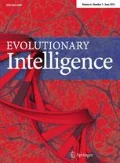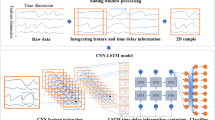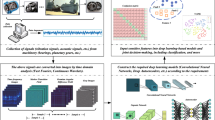Abstract
The fault detection and diagnosis of industrial production process is of great significance to the reliability and safety of modern industrial systems. The data-driven fault detection and diagnosis method can perform statistical analysis and feature extraction on massive industrial control data, and divide the state of the system into normal operation state and fault state. It has attracted extensive attention from academia and industry. In order to achieve accurate and fast identification of industrial production faults, this paper proposes an adaptive multi-task deep learning fault detection model. The model uses an adaptive reweighting module and an improved adaptive pooling method to improve the process of label information acquisition and feature extraction, and improve the performance of the model. To evaluate the method proposed in this paper, the Tennessee Eastman (TE) system, a standard test industrial process in the chemical industry, was selected. The comparison results with the existing work show that the method studied can effectively process industrial control data and can be applied to monitor the occurrence of complex faults in industrial production processes.




Similar content being viewed by others
References
Sun X, Li XG, Li JF, Zhuo L (2017) Review on deep learning based image super-resolution restoration algorithms. Acta Automatica Sinica 43(5):697–709
Zhang QS, Zhu SC (2018) Visual interpretability for deep learning: a survey. Front Inform Technol Electron Eng 19(1):27–39
Ren X, Zhou Y, Huang Z, Sun J, Yang X, Chen K (2017) A novel text structure feature extractor for chinese scene text detection and recognition. IEEE Access 5:3193–3204
Xue-Feng X, Guo-Dong Z (2016) A survey on deep learning for natural language processing. Acta Automatica Sinica 42(10):1445–1465
Druzhkov PN, Kustikova VD (2016) A survey of deep learning methods and software tools for image classification and object detection. Pattern Recognit Image Anal 26(1):9–15
Han J, Zhang D, Cheng G, Liu N, Xu D (2018) Advanced deep-learning techniques for salient and category-specific object detection: a survey. IEEE Signal Process Mag 35(1):84–100
Yolcu G, Oztel I, Kazan S, Oz C, Palaniappan K, Lever TE, Bunyak F (2019) Facial expression recognition for monitoring neurological disorders based on convolutional neural network. Multimedia Tools and Applications 78(22):31581–31603
Zhao YP, Xie YL, Ye ZF (2021) A new dynamic radius SVDD for fault detection of aircraft engine. Eng Appl Artif Intell 100:104177
Wang B, Mao Z (2020) A dynamic ensemble outlier detection model based on an adaptive k-nearest neighbor rule. Inform Fusion 63:30–40
Wang K, Lan H (2020) Robust support vector data description for novelty detection with contaminated data. Eng Appl Artif Intell 91:103554
Wu H, Zhao J (2018) Deep convolutional neural network model based chemical process fault diagnosis. Comput Chem Eng 115:185–197
Ge X, Wang B, Yang X, Pan Y, Liu B, Liu B (2021) Fault detection and diagnosis for reactive distillation based on convolutional neural network. Comput Chem Eng 145:107172
Li C, Zhao D, Mu S, Zhang W, Shi N, Li L (2019) Fault diagnosis for distillation process based on CNN–DAE. Chin J Chem Eng 27(3):598–604
Eom YH, Yoo JW, Hong SB, Kim MS (2019) Refrigerant charge fault detection method of air source heat pump system using convolutional neural network for energy saving. Energy 187:115877
Lee KB, Cheon S, Kim CO (2017) A convolutional neural network for fault classification and diagnosis in semiconductor manufacturing processes. IEEE Trans Semicond Manuf 30(2):135–142
Jiang P, Hu Z, Liu J, Yu S, Wu F (2016) Fault diagnosis based on chemical sensor data with an active deep neural network. Sensors 16(10):1695
Lv F, Wen C, Bao Z, Liu M (2016), July Fault diagnosis based on deep learning. In 2016 American control conference (ACC) (pp. 6851–6856). IEEE
Lv F, Wen C, Liu M, Bao Z (2017) Weighted time series fault diagnosis based on a stacked sparse autoencoder.Journal of Chemometrics, 31(9), e2912
Guo C, Hu W, Yang F, Huang D (2020) Deep learning technique for process fault detection and diagnosis in the presence of incomplete data. Chin J Chem Eng 28(9):2358–2367
Wang Y, Zhang J, Deng F (2017), June A Method of Fault Diagnosis Based on DE-DBN. In Chinese Intelligent Automation Conference (pp. 209–217). Springer, Singapore
Wang Y, Pan Z, Yuan X, Yang C, Gui W (2020) A novel deep learning based fault diagnosis approach for chemical process with extended deep belief network. ISA Trans 96:457–467
Wei Y, Weng Z (2020) Research on TE process fault diagnosis method based on DBN and dropout. Can J Chem Eng 98(6):1293–1306
Yu J, Yan X (2019) Whole process monitoring based on unstable neuron output information in hidden layers of deep belief network. IEEE Trans Cybernetics 50(9):3998–4007
Tang Q, Chai Y, Qu J, Ren H (2018) Fisher discriminative sparse representation based on DBN for fault diagnosis of complex system. Appl Sci 8(5):795
Momeny M, Jahanbakhshi A, Jafarnezhad K, Zhang YD (2020) Accurate classification of cherry fruit using deep CNN based on hybrid pooling approach. Postharvest Biol Technol 166:111204
Mohamed O, Khalid EA, Mohammed O, Brahim A (2017), October Content-based image retrieval using convolutional neural networks. In First International Conference on Real Time Intelligent Systems (pp. 463–476). Springer, Cham
Faris H, Sheta A (2013) Identification of the tennessee eastman chemical process reactor using genetic programming. Int J Adv Sci Technol 50:121–140
Plakias S, Boutalis YS (2020) Fault detection and identification of rolling element bearings with attentive dense CNN. Neurocomputing 405:208–217
Funding
This paper has not received any funding support yet.
Author information
Authors and Affiliations
Contributions
Caihong Zhang contributes to the writing and data analysis; Shengxiao Niu contributes to the conception and methodology.
Corresponding author
Ethics declarations
Conflict of Interest
All authors declare that there is no conflicts of interest in this paper.
Additional information
Publisher’s Note
Springer Nature remains neutral with regard to jurisdictional claims in published maps and institutional affiliations.
Rights and permissions
Springer Nature or its licensor (e.g. a society or other partner) holds exclusive rights to this article under a publishing agreement with the author(s) or other rightsholder(s); author self-archiving of the accepted manuscript version of this article is solely governed by the terms of such publishing agreement and applicable law.
About this article
Cite this article
Zhang, C., Niu, S. Adaptive industrial control data analysis based on deep learning. Evol. Intel. 16, 1707–1715 (2023). https://doi.org/10.1007/s12065-023-00842-2
Received:
Revised:
Accepted:
Published:
Issue Date:
DOI: https://doi.org/10.1007/s12065-023-00842-2




